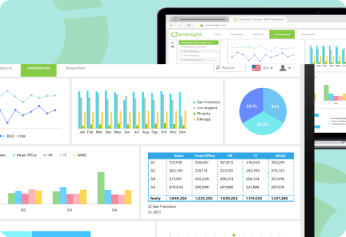Budget variance analysis is a cornerstone of corporate performance management, helping businesses understand financial deviations and make informed decisions. Most organizations perform variance analysis monthly, quarterly, or yearly to stay on track with their goals.
Regular analysis offers critical insights to:
- Identify trends in business performance
- Increase budget accuracy
- Track financial performance
- Manage costs effectively
- Make data-driven decisions
This comprehensive guide explores everything you need to know about budget variance analysis, its importance, calculation methods, actionable steps, and advanced strategies to elevate your financial planning and management practices.
What is Budget Variance Analysis?
Budget variance analysis compares actual financial results to budgeted values for a given period and analyzes the differences. The budget acts as a roadmap for achieving business objectives, and variance analysis evaluates how well the company adheres to it.
This process identifies:
- Favorable variances: Where results exceed expectations.
- Unfavorable variances: Where results fall short.
The insights derived from variance analysis are not just about identifying gaps but also about leveraging them to drive improvements in business operations.
Why Is Budget Variance Analysis Critical for Your Business?
Budget variance analysis is indispensable for effective financial management. Here’s why it’s a game-changer for your business:
1. Improves Financial Performance
Variance analysis helps pinpoint areas where your business exceeded or failed to meet expectations, enabling better allocation of resources.
2. Enhances Predictive Budgeting
By analyzing historical trends, businesses can improve future budgeting accuracy and proactively address potential challenges.
3. Supports Strategic Alignment
Variance analysis ensures that your financial activities align with business goals, making it easier to assess progress and adjust strategies.
4. Boosts Operational Efficiency
Understanding variances can highlight inefficiencies, allowing you to optimize costs and processes.
5. Facilitates Data-Driven Decisions
With detailed insights, leaders can make informed decisions to improve financial and operational outcomes.
Types of Budget Variances
1. Revenue Variance
Measures the difference between actual revenue and budgeted revenue. Causes may include changes in sales volumes, pricing strategies, or market conditions.
2. Cost Variance
Compares budgeted costs with actual costs. Variations can arise from supply chain issues, labor inefficiencies, or unexpected price fluctuations.
3. Profit Variance
Combines revenue and cost variances to assess overall profitability. This holistic view is crucial for evaluating financial health.
4. Labor Variance
Analyzes deviations in labor costs, including wage rates, productivity, and overtime expenses. It’s particularly valuable in labor-intensive industries.
Advanced Types of Variance Analysis
Beyond basic variances, businesses can explore advanced types such as:
- Volume Variance: Measures how changes in output affect revenue and costs.
- Efficiency Variance: Assesses how well resources were utilized compared to expectations.
- Spending Variance: Highlights overspending or underspending in specific budget categories.
How to Calculate Budget Variance?
Calculating budget variance is straightforward:
Budget Variance = Budget Value - Actual Value
Example:
- Budgeted Revenue: $100,000
- Actual Revenue: $90,000
- Variance: $10,000 (unfavorable)
The same formula applies to costs, profits, and other financial metrics. For in-depth analysis, you may need tools like Excel or advanced FP&A software.
Also read: Variance Analysis: Key Tool for Financial Performance Evaluation
Steps to Perform Budget Variance Analysis
1. Consolidate Data
Centralize all financial data, including historical trends, budgeted figures, and actual results. Tools like Limelight FP&A simplify this step by integrating data sources.
2. Calculate Variances
Organize data in a structured format, typically using columns for budgeted values, actual results, and variances. Granular breakdowns—such as by department or project—enhance accuracy.
3. Identify Materiality Thresholds
Set thresholds to prioritize significant variances that warrant deeper investigation. For example, focus on variances exceeding 5% or $20,000.
4. Analyze Variances
Collaborate with relevant departments to understand the root causes of deviations. Both positive and negative variances should be scrutinized for actionable insights.
5. Compile a Management Report
Summarize findings into a clear report, including:
- Key variances
- Root causes
- Recommendations for corrective actions
6. Adjust Forecasts
Use variance insights to update financial forecasts, ensuring they remain accurate and aligned with current trends.
Challenges in Budget Variance Analysis
Data Accuracy: Errors in data collection or integration can compromise the analysis. Centralized, automated tools like Limelight mitigate these risks.
Resource Intensity: Manual analysis can be time-consuming. Automation streamlines workflows and allows teams to focus on strategic activities.
Complex Interdependencies: Variance drivers are often interconnected, requiring careful analysis to avoid incorrect conclusions.
Best Practices for Budget Variance Analysis
Leverage Automation: Automate data gathering, calculations, and reporting with tools like Limelight FP&A to save time and reduce errors.
Focus on Actionable Insights: Prioritize variances with significant business impact and develop clear recommendations for addressing them.
Use Visualizations: Dashboards and charts can make variance analysis more intuitive, enabling faster decision-making.
Integrate Scenario Planning: Model different scenarios to prepare for potential outcomes and mitigate risks effectively.
Why Choose Limelight FP&A for Budget Variance Analysis?
Limelight FP&A is a comprehensive platform designed to elevate your financial planning and analysis processes. Here’s how it stands out:
1. Real-Time Data Integration: Limelight connects with your ERP, CRM, and other systems to provide up-to-date data for accurate variance analysis.
2. Automation at Scale: Eliminate manual data handling with automated workflows, freeing up time for strategic decision-making.
3. Collaborative Platform: Enable cross-departmental collaboration in a centralized workspace, improving alignment and transparency.
4. Interactive Dashboards: Visualize key variances with customizable dashboards that provide actionable insights at a glance.
5. Scenario Planning Tools: Simulate various business scenarios to assess potential outcomes and refine your strategies.
Transform Your Financial Planning with Limelight
Limelight FP&A simplifies budget variance analysis, providing the tools you need to analyze, report, and act on financial variances effectively. With Limelight, you can:
- Save time with automated processes
- Gain deeper insights with real-time data
- Foster collaboration across teams
Ready to take your financial planning to the next level? Schedule a demo today to see how Limelight can revolutionize your budgeting and variance analysis practices.
Table of Contents
Ready to put an end to outdated FP&A?
Get a perzonalized demo




